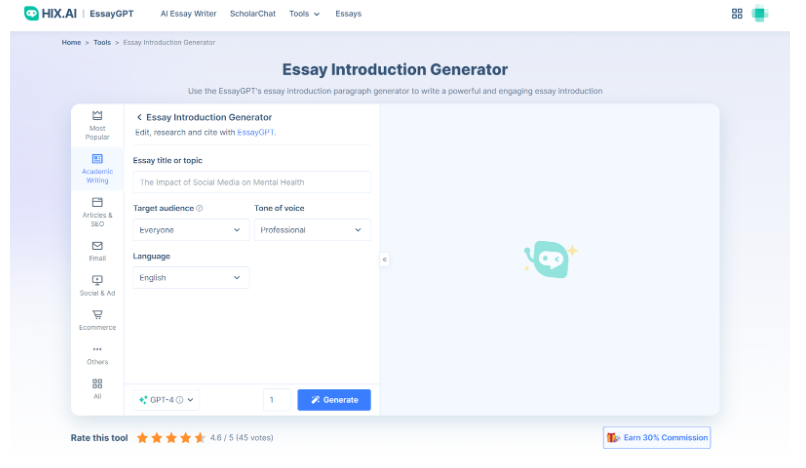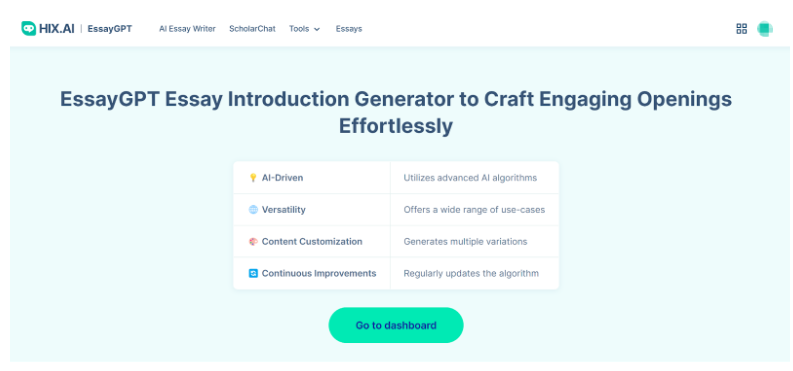Writing an engaging essay introduction is an art. It sets the tone for the rest of your essay, captivates the reader’s interest, and introduces the topic and your unique angle on it. Crafting a compelling introduction is crucial because it is the first impression your reader will have of your work.
In this guide, we will explore various strategies and tips to write an intro that grabs attention and smoothly transitions into your essay’s body, making use of every tool at your disposal, including innovative solutions like the EssayGPT’s essay introduction generator.

Understanding the Purpose of an Essay Introduction
The introduction to your essay serves multiple essential functions in your writing. Its primary goal is to introduce the topic and provide a snapshot of your main argument or thesis statement. Moreover, it aims to engage the reader’s curiosity and encourage them to read on. A well-crafted introduction sets up the context for your argument or discussion, providing a roadmap for the reader to follow.
Key Elements of an Effective Introduction
- Hook: Start with something engaging that will catch the reader’s attention. This could be a question, a quote, a striking statistic, or an intriguing statement.
- Context: Provide background information necessary to understand your topic and argument. This could include historical context, a summary of current debates, or explanations of key terms.
- Thesis Statement: Present your main argument or position clearly and concisely. This statement is the heart of your essay and will guide your writing.
- Signposting: Outline how your essay will be structured. This doesn’t have to be detailed, but it should give the reader a clear idea of what to expect.
Crafting an Engaging Hook
The first few sentences of your introduction are where you need to hook your reader. Consider your audience and the tone of your essay, and choose an opening that fits. A personal anecdote might be perfect for a reflective essay, while a surprising fact could be ideal for an argumentative paper. The key is to pique interest and curiosity.
Providing Context and Background
Once you’ve hooked your readers, it’s time to set the stage for your argument by providing context. This might involve discussing historical background, explaining why the topic is of current interest, or defining important terms. This section should build naturally from your hook and lead seamlessly into your thesis statement.
Formulating a Strong Thesis Statement
Your thesis statement is arguably the most critical part of your introduction. It’s your main argument, the point you will support in the rest of your essay. Ensure it’s specific, arguable, and clearly stated. Avoid vague language and make sure your thesis responds directly to the essay question or prompt.
Structuring Your Introduction
An effective introduction follows a clear structure, leading the reader from the opening hook through the background context and directly to the thesis statement. The flow should feel natural, with each part logically leading to the next.
Utilizing Tools like EssayGPT’s Essay Introduction Generator
In the digital age, tools like the Essay Introduction Generator by EssayGPT provide a creative and innovative way to tackle the sometimes daunting task of beginning an essay. After inputting your topic and selecting your desired tone, this AI-powered tool can generate engaging and customized introductions. Whether used as a source of inspiration or as a foundation to build upon, such a tool can streamline the writing process and spark creativity, offering a modern solution to a traditional writing challenge.
The Advantages of Using an AI-Assisted Tool

- Creativity Boost: Starting can often be the hardest part. An AI tool can provide that initial push, offering creative opening lines or suggestions you might not have considered.
- Time Efficiency: It can speed up the writing process by handling the often time-consuming task of crafting an introduction, allowing you to focus on developing your arguments and refining your essay.
- Customization: With options to tailor the output to your specific needs, you can ensure the introduction fits your essay’s tone and audience.
- Inspirational Source: Even if you prefer to write your introduction, seeing different ways to approach your topic can inspire new angles and insights.
Polishing Your Introduction
After drafting your introduction, it’s essential to revisit and refine it. Ensure it aligns with the body of your essay and your thesis statement accurately reflects the main arguments you’ve made. Reading it aloud can help you catch any awkward phrasing or logical jumps, and feedback from peers or instructors can offer valuable perspectives you might have missed.
Conclusion
The introduction is your first opportunity to engage your readers and lay the foundation for a compelling essay. By crafting a strong hook, providing relevant context, clearly stating your thesis, and considering the flow of your introduction, you can create a powerful opening for your essay. In today’s digital age, leverage every tool available, such as the EssayGPT’s essay introduction generator, to enhance your writing process. Remember, a great introduction sets the stage for a persuasive and coherent essay, so invest time in making it as effective as possible.



